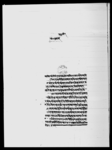A lālamohara from King Rājendra reconfirming the exemption of Guruṅs, Ghales and Lāmās from legal restrictions relating to aputālī, cākacakuī and pharneulo (VS 1885)
ID: DNA_0012_0053
Edited and
translated by Christof Zotter
Created: 2017-07-17;
Last modified: 2020-11-17
For the metadata of the document, click here
The accompanying edition, translation/synopsis and/or commentary are available under the terms of the Creative Commons Attribution-ShareAlike 4.0 International License
Abstract
This lālamohara of King Rājendra, addressing Guruṅs, Ghales and Lāmās throughout the realm, sanctions a thiti bandeja through a copperplate, according to which the addressees are granted an exemption from payment of cākacakuī and pharneulo fines, the state acquisition of aputālī, and enslavement as punishment for other offences. It is furthermore specified that lāmās and ghyābriṅs can be employed as necessary, but that Brahmanical rituals shall be conducted by Upādhyā Brahmins.Diplomatic edition
[1r]
1श्रीदुर्गा\1श्री५वुवाज्यु[royal seal]1स्वस्तिश्रीगिरिराजचक्रचुडामणिनरनाराय़णेत्यादि2[...]विरुदावलीविराजमानमानोन्नत्श्रीमन्महा
3[?]जाधिराजश्रीश्रीश्रीमहाराजराजेन्द्रविक्रमसाहव•
4[?]दुरसम्सेरजङ्गदेवानाँसदासमरविजयिनाम्¯ ¯ ¯
5आगेहाम्राभरमुलुकका•गुरुंघलेलामागैर्हके¯ ¯
6¯ ¯ ¯वाटअपुतालीचाकचकुईमाफगरिवक्सनु
7[...]कोरहेछआजहामीवाटपनितिमिहरूकाअघि
8देषीचलीआयाकोरितिथितिअपुतालीचाकचकुई•
9फर्नेउलोहाम्रादर्वारमापस्याकापसुईव़ाहेकमाफ
10[...]रि•लामाघ्याव्रिंलेगर्नुपार्न्याकामलामाघ्याव्रिंवाट
11[...]राउनुव्राह्मणवाटगराउनुपार्न्याकामउपाध्याव्राह्म•
12णवाटगराउनुऔविराव़माफिककाषतमाडंडसा
13[...][...]र्नुजियनमासनुभनिथितिवंदेजवाँधिताम्वा•
14पत्रगरिवक्स्यौंईतिसंवत्१८८५सालमितिचैत्रवदि१०
15रोज२शुभम्¯¯ ¯¯ ¯¯ ¯¯ ¯¯
Translation
[1r]
Śrī Durgā
Fivefold Venerable Father
[royal seal]
Hail! [A decree] of him who is shining with manifold rows of eulogy [such as] ‘The venerable crest-jewel of the multitude of mountain kings’ and Naranārāyaṇa (an epithet of Kṛṣṇa) etc., high in honour, the venerable supreme king of great kings, the thrice venerable great king, Rājendra Vikrama Śāha, the brave swordsman, the divine king always triumphant in war.
Āge: To Guruṅs, Ghales, Lāmās etc. throughout our realm
[You] were granted by [our] ----1 an exemption from [the state aquisition of] escheatable property (aputālī) and [the payment of] fines for illicit intracommunal sexual relations (cākacakuī).2 Today we, too, have issued a copperplate sanctioning the [following] custom (thiti bandejabā̃dhi): "In line with the customary practice of your households since earlier times,3 [all of you]—except for pasuīs 4 who enter our palace (darabāra)— are exempted from [the state aquisition of] escheatable property (aputālī) [and fines relating] cākacakuī5 and pharneulo.6 As for rituals (kāma) that need to be conducted by lāmās and ghyābriṅs, let lāmās and ghyābriṅs conduct them, but rituals that need to be conducted by Brahmins shall be conducted by Upādhyā Brahmins.7 Moreover (au), as punishment for [other] wrongdoing (birāva), [the authorities] shall punish [you] according to the infringements, [but you] are not to be enslaved."
Monday,8 the 10th of the dark fortnight of Caitra [of the Vikrama] era year 1885 (1829 CE).9
Commentary
Another edition of this lālamohara, based on a photograph of a copy kept in the Lagata Phā̃ṭa (cf. Fezas 1986: 172) and containing a number of graphic variants (such as aputāli for aputālī or birāu for birāva), is available in Fezas 1986: 174. The document is also mentioned in the Appendix "Royal decrees concerning the Gurung" in Pignède 1993: 491, where a number of other edicts relating to cākacakuī, aputālī and Guruṅ priests are summarized. It is an altered version of a copperplate promulgated on Vaiśākha śudi 10 VS 1883 (DNA_0014_0022), from which it differs (ignoring the common orthographic variants) mainly in the removal of the words cārajāta and sorhajāta from the list of addressees (for further details, see Commentary in DNA_0014_0022).
On similar arrangements made for other ethnic groups, see Commentary in DNA_0013_0069.

